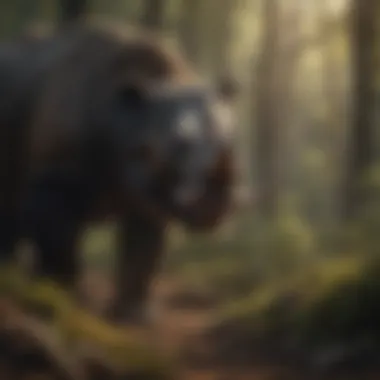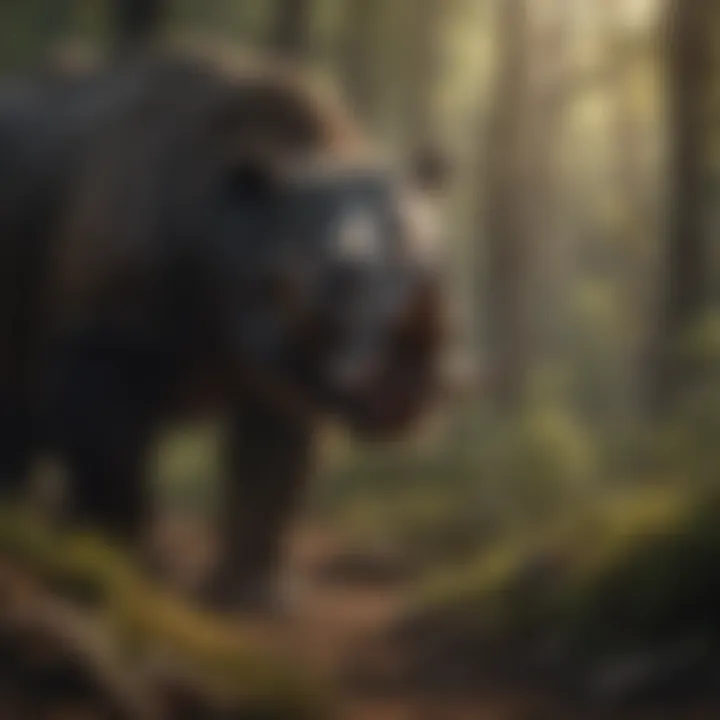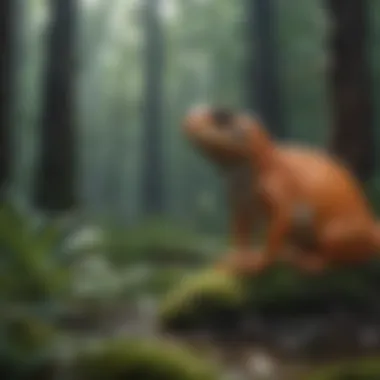Understanding Endangered Species: Causes and Effects


Intro
The intricate issue of endangered species is a pressing concern in today’s world. Declining populations of various species may lead to irreversible consequences not only for ecosystems but also for humanity. Understanding the causes underlying this decline is essential for developing effective conservation strategies. Key factors invite scrutiny. Habitat destruction due to urbanization and agriculture drastically reduces living space for many species. Climate change, influenced by human activities, alters habitats and food sources for wildlife. Poaching remains a persistent threat, driven by demand for animal products.
Efforts to address these issues necessitate a broad understanding of their ecological, economic, and ethical implications. It is imperative to recognize the connections between these factors and our well-being. The survival of endangered species is closely intertwined with human health, economic stability, and biodiversity. Diverse ecosystems offer services such as clean air, pollination of crops, and resilience to climate variability. As such, comprehending the decline of species transcends mere academic inquiry; it calls for a committed response to mitigate the danger of further losses.
Preamble to Endangered Species
Understanding endangered species is crucial in the context of environmental conservation and biodiversity. It is not merely an academic exercise but a vital aspect of sustaining our ecosystems and addressing pressing global issues. This section will elucidate the definitions and significance of endangered species, providing a framework for the discussions that follow in the article.
Defining Endangered Species
Endangered species refer to those animal and plant species that are at risk of extinction in the near future. The classification of a species as endangered can be based on various criteria, including population size, habitat range, and threats faced by the species. Several organizations, including the International Union for Conservation of Nature (IUCN), maintain lists that categorize these species based on their risk levels, such as vulnerable, endangered, or critically endangered. The definition of endangered species underscores the urgency for conservation efforts.
The causes for a species to reach this vulnerable status often relate to human activity. This includes habitat destruction, overexploitation through poaching, and introduction of invasive species. Beyond just numbers, defining endangered species entails understanding the intricate relationships within ecosystems that can lead to a drastic imbalance if certain species decline.
Importance of Biodiversity
Biodiversity encompasses the variety of life on Earth, including the different species, genetic variations, and ecosystems. Its importance cannot be overstated. Biodiversity contributes to ecosystem resilience, allowing environments to recover from disturbances and adapt to changes.
The loss of biodiversity has cascading effects. When species become extinct, the intricate food webs that support our planet's life can begin to unravel. For example, the decline of a single predator can lead to an explosion in herbivore populations, which can decimate plant life and ultimately lead to further extinctions.
Promoting biodiversity is not only about preserving aesthetic beauty or the intrinsic value of species. It plays a fundamental role in ecosystem services that humanity relies on, such as clean air and water, pollination of crops, and disease regulation. Therefore, understanding the significance of biodiversity is essential for informed conservation actions.
"Biodiversity is a safeguard for all life on Earth; protecting it is essential for our survival."
In summary, the introduction to endangered species provides a foundational understanding of what these terms mean and why they matter. The subsequent sections of the article will explore the immediate and long-term implications of endangerment, offering a deep dive into the primary causes and their effects.
Primary Causes of Endangerment
The primary causes of endangerment reflect urgent issues within our ecosystems that need addressing. Understanding these causes is crucial for any conservation strategy. Identifying the specific factors leading to species decline helps direct efforts and resources more effectively. Additionally, this understanding lays the groundwork for policies and actions aimed at reducing the risks faced by vulnerable species.
Habitat Destruction
Habitat destruction plays a key role in the endangerment of species. As human activity expands, natural habitats are modified or completely removed. This includes actions such as logging, agriculture, and urbanization, which are often prioritized over environmental health.
Deforestation
Deforestation has severe impacts on biodiversity. When forests are cut down, many species lose their homes. The loss of trees also affects climate regulation and soil stability. Forests offer more than just habitat; they regulate water cycles and provide resources for many species. As a result, deforestation is intricately linked to the decline of numerous species.
Urban Development
Urban development leads to fragmentation of habitats. As cities grow, they eliminate open spaces. This reduction in habitat quantity leads to a decrease in species richness. Different species rely on these open areas for their survival, thus urban planning must consider ecological impact integrating green spaces is beneficial for species conservation.
Pollution Impact
Pollution severely harms wildlife and their ecosystems. Chemicals in water, air, and soil can lead to health issues for many species. Pollutants can enter food chains, causing accumulation and toxic effects on larger animals. Pollution management is crucial to maintaining biodiversity and protecting endangered species from further decline.
Climate Change Effects
Climate change presents another significant threat to endangered species. The changing climate affects temperatures, weather patterns, and habitats. Species unadapted to these rapid changes face increased survival challenges.
Temperature Changes
Temperature changes directly influence species' survival and reproduction. Many species have specific temperature ranges in which they thrive. As temperatures shift, some species may migrate, while others may face extinction due to inability to adapt. This aspect highlights the urgency in understanding their ecological needs.
Sea Level Rise
Sea level rise threatens coastal habitats. As sea levels increase, wetlands and coastal ecosystems disappear. This loss impacts numerous species that rely on coastal habitats for survival and reproduction. Additionally, increased salinity from seawater intrusion affects freshwater species, amplifying the endangerment of multiple species.
Altered Ecosystems
Climate change not only affects temperature but also disrupts entire ecosystems. Changes in plant life can lead to changes in available food sources for animals. This chain reaction can make habitats uninhabitable for certain species, further driving them toward endangerment.
Poaching and Illegal Trade
Poaching and illegal trade are significant contributors to species decline. Targeting specific animals for profit undermines conservation efforts. High-value species are especially vulnerable and face a high risk of extinction.
Targeted Species
Targeted species such as elephants and rhinos are often hunted for their tusks or horns. The illegal trade in wildlife products can deplete populations drastically. The combination of high demand and low reproductive rates leads to critical population declines, making these species prone to extinction.
Impact on Population Dynamics
The impact of poaching extends beyond the targeted animals. When key species are removed from ecosystems, the balance is disrupted, affecting many other organisms. Loss of apex predators, for example, can lead to overpopulation of herbivores, causing further ecological imbalance. This dynamics complicates conservation efforts.


Regulatory Gaps
Regulatory gaps in wildlife protection laws can facilitate illegal practices. In many regions, enforcement of existing laws is weak, allowing poachers to operate without consequences. Policymakers must strengthen laws and their enforcement to protect endangered species effectively.
Invasive Species
Invasive species can disrupt local ecosystems and contribute to the endangerment of native species. They often outcompete native organisms for resources such as food and habitat.
Competition for Resources
Invasive species can thrive in new environments due to lack of natural predators. This competition leads to a decline in native species as they struggle to survive. Understanding this competition is essential for developing effective conservation strategies.
Disease Transmission
Invasive species can introduce new diseases to native populations. Such diseases may devastate species lacking immunity, leading to significant demographic declines. This aspect underscores the importance of monitoring and controlling invasive species to protect native biodiversity.
Predatory Dynamics
Invasive predators can severely threaten indigenous species. When non-native predators are introduced, they can decimate populations of local prey species. This predatory pressure can result in rapid declines and is a key factor in the endangerment of various species.
Pollution
Pollution continues to be a critical factor impacting species endangerment. Different forms of pollution affect the health of ecosystems.
Chemical Contaminants
Chemical contaminants from industrial and agricultural sources can poison various species. Species that inhabit polluted environments can experience health issues that affect reproduction and survival rates. This highlights the need for mitigative strategies.
Plastic Waste
Plastic waste represents a substantial environmental threat. It pollutes oceans and landscapes, affecting wildlife that ingest or become entangled in it. Efforts to reduce plastic use are vital in every conservation agenda.
Noise Pollution
Noise pollution affects animal behavior and communication. Species reliant on sound for communication may struggle to function in noisy environments. Disruption of regular behaviors due to noise makes it a less recognized but significant threat to many species' survival.
Consequences of Endangerment
Understanding the consequences of endangerment is crucial in recognizing the broader impacts on both ecosystems and human society. When species decline, it disrupts the delicate balance that sustains nature. This aspect of endangerment draws attention to specific elements such as biodiversity loss, economic ramifications, and ethical considerations. Comprehensive awareness of these topics is necessary for effective conservation efforts and policies that strive to ameliorate these issues.
Impact on Ecosystems
Biodiversity Loss
Biodiversity loss represents a significant consequence of species endangerment. Each species plays a unique role within its ecosystem, contributing to the intricate web of life. The loss of biodiversity can lead to decreased resilience within ecosystems. A crucial characteristic of biodiversity loss is the diminishing variety of life forms, which weakens ecosystem functionality. This is a relevant point in this article because it directly affects the sustainability of environments that support human life.
The unique feature of biodiversity is its ability to maintain ecological balance. With fewer species, there is an increased risk of collapse within ecosystems, which can affect services such as pollination and water purification.
Food Chain Disruption
Food chain disruption is another direct effect of species endangerment. When predator or prey species decline in number, the entire food web can be affected. A key characteristic of food chain disruption is its ripple effect, where changes in one group lead to unforeseen consequences in others. This is beneficial for this article since understanding these interconnections aids in grasping the urgency of conservation.
Uniquely, the food chain relies on dynamic relationships among species. Disruption can lead to overpopulation of certain species, resulting in resource depletion and habitat degradation.
Ecosystem Services Decline
The decline in ecosystem services is a critical element linked to endangered species. Ecosystem services include processes like nutrient cycling, climate regulation, and waste decomposition. The key characteristic here is that these services are often overlooked until they start to diminish, impacting agricultural productivity and water quality.
A unique feature of ecosystem services is their direct linkage to human well-being. As these services decline due to species endangerment, we face increasing challenges in maintaining a stable food supply and a clean environment.
Economic Ramifications
Tourism Effects
Tourism can significantly be affected by the endangerment of species. As unique wildlife becomes scarce, regions known for their biodiversity lose appeal. A vital characteristic of tourism in this context is its reliance on the presence of diverse species for attraction. This aspect enriches this article as it underscores how economic interests align with conservation efforts.
The unique feature of tourism impacts can stimulate local economies and lead to sustainable practices. However, if species continue to decline, the potential revenue from eco-tourism diminishes, affecting jobs and livelihoods.
Resource Availability
Resource availability often suffers due to the drop of endangered species. This decline can influence access to important materials from natural sources. A notable characteristic of resource availability is its critical role in industries such as pharmaceuticals and agriculture. This focus is beneficial for this article by illustrating how conservation of species can lead to economic benefits.
Unique to this area, the loss of particular species can mean the loss of resources that contribute directly to human health and economic productivity, particularly in developing regions.
Medicinal Impact


The medicinal impact of species endangerment highlights how biodiversity loss can affect medical research and drug development. Many modern medicines are derived from natural compounds found in plants and animals. The key characteristic of this impact is its long-term implications on healthcare innovation. This is a crucial aspect for the article as it emphasizes the intersection of conservation and human health.
One unique feature is the potential for undiscovered species to hold promising medicinal properties. As these species dwindle, the chance of discovering novel treatments decreases, illustrating a significant disadvantage of biodiversity loss.
Ethical Considerations
Species Extinction Ethics
Ethical considerations regarding species extinction raise essential questions about our responsibility toward the natural world. The key characteristic of species extinction ethics stems from the recognition that humans have an obligation to preserve the life forms with which we share the Earth. This topic is a beneficial aspect to explore in this article, highlighting moral arguments surrounding conservation efforts.
A unique feature of this consideration is how it invokes discussions on biocentrism, asking if all forms of life hold inherent value, regardless of their utility to humans.
Human Responsibility
Human responsibility plays a vital role in the ongoing conversation about conservation. The key characteristic here is the acknowledgment that human actions significantly impact the environment. This aspect is crucial for this article, as it emphasizes the importance of accountability in mitigating adverse effects on endangered species.
One unique feature of human responsibility is the potential for collective action within communities. Encouraging collaborative efforts can lead to sustainable practices that benefit both species and people.
Conservation Value
The value of conservation represents a powerful argument for protecting endangered species. Highlighting the key characteristic of conservation value is the recognition that safeguarding biodiversity contributes to the overall health of ecosystems and human society. This is indeed a beneficial aspect for this article as it illustrates the interconnectedness of environment and humanity.
A unique feature of conservation value lies in its multifaceted nature, encompassing ecological, economic, and ethical dimensions, making a compelling case for the urgent need for action.
Conservation Efforts
Conservation efforts play a vital role in the survival of endangered species. The significance of these initiatives extends beyond mere preservation; they foster a balanced ecosystem and contribute to the overall health of our planet. By addressing threats, such as habitat destruction and climate change, conservation aims to protect not only species but also the intricate webs of life they are part of. Various methods and policies exist, which can effectively mitigate risks, engaging both local communities and international parties in tackling this pressing issue.
Protected Areas
Protected areas are designated spaces where human activity is restricted in order to safeguard wildlife and their habitats. These areas are essential in protecting biodiversity and maintaining ecosystem functions.
National Parks
National parks serve as a cornerstone of conservation efforts. They provide a haven for countless species and maintain essential environmental processes. The key characteristic of national parks is their legal protection, which limits development and resource extraction. This makes them a beneficial choice for conservation, as they ensure ecosystems remain largely unaffected by human interference.
National parks also draw public interest and stimulate ecotourism, generating funds for further conservation projects. A unique feature of national parks is their ability to educate the public about nature and conservation, offering visitors firsthand experience with wildlife. However, challenges, such as overcrowding and management issues, can emerge, potentially compromising their initial goals.
Wildlife Reserves
Wildlife reserves focus specifically on protecting animal populations and their habitats from disturbances. The key characteristic of wildlife reserves is their targeted management programs that often include breeding and rehabilitation initiatives. This makes them a popular choice for conservationists aiming to ensure specific species recover from the brink of extinction.
Wildlife reserves often employ local communities in conservation efforts, fostering a sense of ownership and responsibility. A unique feature of these reserves is their flexibility in management strategies that can be swiftly adapted to changing conditions. Conversely, the effectiveness of reserves can be undermined by limited funding and insufficient legal protections against poaching or exploitation.
Marine Protected Areas
Marine protected areas (MPAs) are essential for the conservation of marine biodiversity. They help mitigate the negative impacts of overfishing, climate change, and pollution. The key characteristic of MPAs is their ability to protect entire ecosystems, including coral reefs and fish populations. This makes them a beneficial choice for conservation, as they contribute to the overall resilience of ocean environments.
MPAs create safe havens for species to thrive and regenerate, supporting local fisheries in the long term. A unique feature of MPAs is their capability to promote research and education on marine ecosystems. On the downside, establishing and enforcing MPAs can sometimes face opposition from fishing communities, who may see them as a threat to their livelihoods.
Legislation and Policy
Legislation and policy provide a framework within which conservation efforts can thrive. Strong policies are needed to enforce protections and promote sustainable practices. Without effective legal structures, initiatives may lack the necessary support to succeed.
Endangered Species Act
The Endangered Species Act (ESA) is a landmark piece of legislation aimed at protecting at-risk species. Its key characteristic is its comprehensive protection system for both listed species and their habitats. This makes it a beneficial choice for conservation, as it provides robust legal grounds for safeguarding biodiversity.
The ESA also facilitates habitat restoration and encourages recovery plans for endangered species. A unique feature of the ESA is its ability to draw attention to the ecological importance of these species. However, it sometimes encounters challenges, such as political resistance and funding limitations, that diminish its overall impact.
CITES
The Convention on International Trade in Endangered Species of Wild Fauna and Flora (CITES) regulates international trade of endangered species. Its key characteristic is the establishment of trade restrictions based on conservation concerns. This policy represents a beneficial choice for controlling illegal trafficking.
CITES facilitates cooperation among nations in preserving wildlife and offers guidelines for sustainable use. A unique feature of CITES is its international reach, promoting global accountability. Nonetheless, the effectiveness of CITES can be hindered by inconsistent implementation across different countries.
Local Regulations
Local regulations play a critical role in community-specific conservation efforts. Their key characteristic is their focus on localized issues, addressing regional environmental concerns directly. This makes local regulations a beneficial choice for tailored conservation strategies, enabling communities to engage in protecting their natural resources.
Local regulations often support biodiversity by creating specific measures suited to unique ecosystems. A unique feature of local regulations is their capacity to adapt to changing conditions, allowing communities to respond quickly to threats. However, these regulations may lack sufficient resources or enforcement mechanisms, limiting their effectiveness.
Community Engagement
Community engagement is essential for sustainable conservation efforts. By involving local populations, initiatives gain crucial support and foster greater awareness of environmental issues. This approach encourages a sense of responsibility and ownership among community members.


Local Initiatives
Local initiatives aim to empower communities to take charge of conservation efforts in their areas. Their key characteristic is grassroots participation, ensuring that local needs and values are considered. This makes local initiatives a beneficial choice for authentic conservation practices.
These initiatives often lead to the preservation of traditional ecological knowledge, promoting sustainable resource management. A unique feature is their adaptability to local conditions, fostering innovation in conservation. However, lack of funding or external support can hinder the long-term success of these initiatives.
Education Programs
Education programs focus on raising awareness about endangered species and conservation. The key characteristic of these programs is their emphasis on informing and inspiring communities. This makes education programs a beneficial choice for fostering a culture of conservation.
Well-implemented education programs can spark action within communities, leading to greater involvement in conservation efforts. A unique feature is the capacity to reach diverse audiences, including youth, fostering a generational shift in conservation awareness. The challenge lies in securing necessary resources for sustained program delivery.
Volunteer Conservation
Volunteer conservation enables individuals to contribute directly to conservation projects. Its key characteristic is the hands-on involvement of community members. This makes volunteer conservation a beneficial choice for grassroots engagement in conservation efforts.
Volunteer opportunities can help enhance local knowledge and bolster community ties. A unique feature is the enrichment of participants' understanding of ecological processes. However, inconsistent volunteer commitment can affect project outcomes, necessitating careful planning and communication.
The Role of Technology in Conservation
Technology has become an essential part of conservation efforts. It enhances our ability to monitor, manage, and protect endangered species. The integration of modern technology helps tackle the complex issues faced by conservationists today. It allows for better data collection, powerful analysis, and innovative practices that can substantially improve outcomes for biodiversity and ecosystems. As the threats continue to evolve, technology provides tools to adapt and respond effectively.
Data Collection and Monitoring
Remote Sensing
Remote sensing refers to the use of satellite or aerial imagery to gather information about the Earth's surface. This technique helps in mapping habitats and identifying changes over time. One major advantage of remote sensing is its ability to cover large areas quickly. The key characteristic is its capacity to assess data from a distance, making it non-intrusive and efficient.
However, while remote sensing provides extensive data, it may lack the granularity sometimes needed. Details about smaller habitats or specific species may not always be captured. Nonetheless, its ability to track changes in land use and habitat loss makes it a valuable tool in conservation efforts.
Field Surveys
Field surveys involve direct observation and study of wildlife in their natural habitats. This method contributes significantly to understanding the behavior, population dynamics, and health of various species. The uniqueness of field surveys lies in their hands-on approach, allowing researchers to gather more personalized data. They can observe interactions within ecosystems, which is crucial for assessing impacts on endangered species.
However, field surveys can be time-consuming and often require extensive resources. Additionally, accessing remote areas may pose challenges. Despite these limitations, field surveys create a rich database for local populations and seasonal variations that remote techniques cannot provide as effectively.
Genetic Analysis
Genetic analysis is vital for understanding genetic diversity in endangered populations. It enables researchers to determine the health and viability of species by examining their genetic makeup. This technology offers critical insights into the genetic variability, which can inform breeding programs and conservation strategies.
The key feature of genetic analysis is its ability to detect inbreeding and other subpopulation issues. It can guide conservationists in making informed decisions regarding the appropriate interventions.
One drawback is the need for specialized training and equipment, which may not be available in all regions. Yet, genetic insights remain a cornerstone of modern conservation strategy, helping prioritize species in need of urgent action.
Innovative Conservation Practices
Drone Technology
Drones have revolutionized wildlife monitoring. They can access difficult terrain and gather high-resolution imagery without disturbing wildlife. Their ability to cover vast areas efficiently is unmatched. Drones can also capture real-time data, providing immediate insights for conservationists.
However, drones come with limitations such as regulatory challenges and potential disruptions to wildlife. Nevertheless, their unique features enhance data collection and management, contributing significantly to ongoing conservation efforts.
Ecosystem Restoration Techniques
Ecosystem restoration techniques focus on rehabilitating damaged habitats. They are crucial for reestablishing biodiversity and restoring natural processes. The key characteristic of these techniques is their adaptability. They can be tailored to suit specific ecosystem needs and involve local communities in implementation.
However, successes may vary based on the complexity of systems. Waiting for ecosystems to recover can be a long-term process. Yet, the value of restoring ecosystems far outweighs the challenges, often yielding long-lasting benefits.
Biotechnological Interventions
Biotechnological interventions include a range of techniques, from genetic editing to cloning. These methods can help increase resilience in endangered species and restore genetic diversity. The key characteristic of biotechnology is its precision, allowing for targeted actions that can address specific threats.
However, ethical considerations arise regarding manipulation of species. Concerns about unintended consequences must be carefully evaluated. Despite these challenges, biotechnological tools offer exciting possibilities for innovative conservation solutions.
Culmination
The conclusion of this article on endangered species is a crucial element that synthesizes the discussions held throughout the previous sections. It serves not only to summarize key points but also to reinforce the significance of addressing endangered species and their plight. The loss of biodiversity impacts both ecosystems and human life; thus, understanding the interconnectedness of these aspects is vital.
In this article, we have explored various causes that lead to the endangerment of species. Habitat destruction has been identified as a major factor, alongside climate change and poaching. Each of these elements not only endangers wildlife but also disrupts ecological balance, which in turn influences human survival.
Summary of Key Points
- Habitat Destruction: The ongoing loss of natural environments due to urbanization, agriculture, and industrial activities is a leading cause of species endangerment. It limits the capacity of these species to thrive and reproduce.
- Climate Change: Rising temperatures and changing weather patterns alter habitats, making it difficult for many species to adapt. Ocean acidification is also affecting marine life significantly.
- Poaching Influence: Illegal hunting of species for their parts leads to drastic declines in population, threatening species like elephants and tigers.
- Invasive Species: Non-native species can outcompete, prey on, or introduce diseases to local wildlife, further complicating conservation efforts.
- Pollution Impact: Chemicals, plastic waste, and noise pollution pose serious threats to biodiversity, affecting both land and marine ecosystems.
The consequences of these threats extend to economic ramifications and ethical concerns. The article highlights how the loss of species can reduce resources available for future generations, hinder tourism, and challenge human responsibilities in conservation efforts.
Call to Action
It is essential for readers to understand that they can contribute to conservation efforts in meaningful ways. First, increasing awareness about the issues surrounding endangered species can strengthen collective action.
- Get Involved: Participate in local conservation initiatives. Engage with organizations like the World Wildlife Fund or The Nature Conservancy.
- Advocacy: Support policies that protect habitats and regulate illegal trading of wildlife. Communicating with local representatives can lead to positive legislative changes.
- Education: Share knowledge with others about the importance of biodiversity. Consider resources from educational platforms like en.wikipedia.org or britannica.com.
- Reduce, Reuse, Recycle: Every small step toward reducing personal waste can lead to significant positive impacts on the environment.
Ultimately, preserving endangered species is not just a benefit to ecosystems; it is a necessity for human society. By taking deliberate actions today, we can safeguard our natural world for the generations to come.



